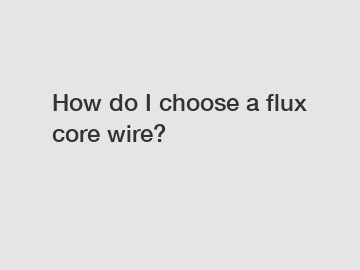How do I choose a flux core wire?
When it comes to choosing the right flux core wire for your welding projects, there are several factors to consider. In this article, we will explore the key aspects that can help you make an informed decision. The selection of an appropriate flux core wire is crucial as it significantly affects the quality and strength of the weld. By understanding the different types of flux core wires available, their characteristics, and the specific requirements of your project, you can make the right choice.
One of the first considerations in choosing a flux core wire is the type of metal you will be welding. Flux core wires are designed for different base metals, such as mild steel, stainless steel, or aluminum. Matching the wire type to the base metal is essential for achieving the desired results. For instance, if you are working with stainless steel, you would need a stainless steel flux core wire to ensure proper fusion and prevent corrosion.

Another crucial factor to consider is the diameter of the wire. The diameter of the flux core wire affects the welding process and the overall quality of the weld. Thicker wires, such as 0.035 inches or 0.045 inches, are suitable for heavy-duty applications that require higher deposition rates and better penetration. On the other hand, thinner wires, like 0.030 inches, are more suitable for thin metals or light-duty welding.
The position in which you will be welding also plays a role in choosing the right flux core wire. Different wires are designed for specific welding positions, such as flat, horizontal, vertical, or overhead. Each position requires a wire that provides the necessary deposition rate, penetration, and control. Therefore, it is essential to select a wire that is compatible with the welding position you will be working in.
Additionally, the shielding gas requirements should be considered. Some flux core wires are self-shielding, meaning they do not require an external shielding gas. These wires are ideal for outdoor welding or situations where it is challenging to provide a shielding gas. However, if you have access to a shielding gas, using a gas-shielded flux core wire can offer better control over the welding process and produce cleaner welds.
Lastly, you should also take into account the specific requirements of your project, such as the desired weld appearance, strength, and environmental conditions. Different flux core wires have varying characteristics, such as the amount of spatter produced, the ease of slag removal, and the overall weld quality. Evaluating these factors in relation to your project requirements will help you select a flux core wire that yields the desired results.
In conclusion, choosing the right flux core wire for your welding projects requires considering factors like the type of base metal, wire diameter, welding position, shielding gas requirements, and project-specific requirements. By understanding these aspects and their implications on the welding process, you can make an informed decision that ensures the desired weld quality and strength. Remember that selecting the appropriate flux core wire contributes significantly to the success of your welding projects.
If you are looking for more details, kindly visit weld overlay plate, Wear Plate Supplier, china chromium carbide steel plate.



Comments
Please Join Us to post.
0